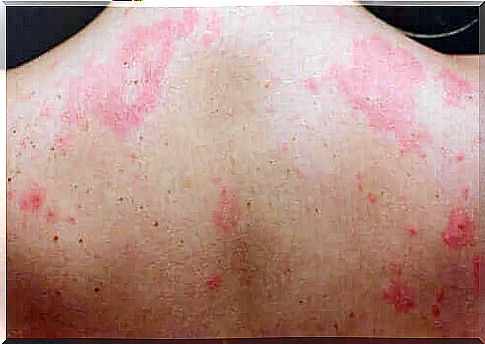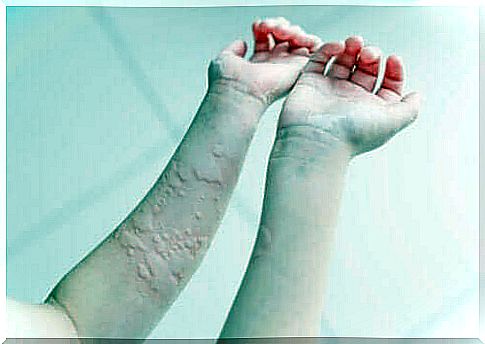Chronic Urticaria: Different Types And Their Characteristics
Chronic urticaria is a disease in which hives and itching occur over a period of more than six weeks. Despite all efforts, the causes of this pathology are still unknown.

Chronic urticaria is a skin disease that is characterized by the appearance of skin lesions that are manifested in various ways. A rash and severe itching will usually appear on the affected area. According to various studies , an estimated 20% of the world’s population has been affected.
It is important to be familiar with the causes of urticaria in order to be able to deal with it effectively. This is mainly due to the high prevalence and inconvenience of the clinical picture, the different types and epidemiology. In today’s article we will focus on chronic urticaria .
Context and frequency of the disease
Before you can delve into the specifics of a disease, you first need to know how the dynamics of manifestation evolve over time. In fact, it is one of the first steps in planning treatment and relief for the condition.
An article in the Revista Médica de Buenos Aires provides some interesting facts about urticaria:
- It is estimated that between 15 and 25% of the world’s population has had it at least once in a lifetime.
- Chronic urticaria has a prevalence of around 1%, which means that it affects 1 in 100 people.
- In addition, it occurs as an isolated case in 45% of cases and with angioedema (swelling of the skin) in the remaining 55%.
We would also like to point out that a distinction is currently made between two types of urticaria. If the episodes of illness last less than six weeks, it is an acute form, after which it is called chronic urticaria. As strange as it may seem, more than 80% of the time, there is still insufficient information about the cause and origin of this condition.

Chronic urticaria: types
Since chronic urticaria occurs on the surface of the skin, one could suspect that it is a harmless disease. However, the different types of this chronic disease can have a significant impact on the quality of life of the person concerned. Clinical studies compare the effects of this condition with those of some heart conditions.
According to the Asociación de Afectados por la Urticaria Crónica (AAUC), their various causes are usually related to the following processes:
- Autoimmune reactions
- Intolerance and hypersensitivity to certain drugs
- Infectious processes
- Food allergies
For chronic urticaria there is no official distinction between different types and international medical institutions have confirmed this. However, it can be classified according to the triggering factors. These are the three most common causes:
Autoimmune reactions
Dermatological studies have shown that this is the most common cause. According to estimates, autoimmune reactions are the cause in 45% of cases. The body itself activates immune cells, and these release histamine (a substance related to the immune system). Hives then appear.
However, other medical articles indicate that there is still insufficient knowledge about this mechanism. This is because the trigger that activates the immune system’s mediating antibodies is not yet fully understood. Thyroid disease (such as autoimmune thyroiditis) has been associated with it in around 15% of cases.
Chronic urticaria due to infection
Some infectious processes and viruses, bacteria and fungi can promote the development of chronic urticaria. Among others the following:
- The hepatitis A and B viruses
- Streptococcus infestation
- Mycobacterium tuberculosis (the bacterium that causes most tuberculosis cases worldwide)
- The herpes simplex virus
In particular, we would like to mention the case of Helicobacter pylori infection, a bacterium that lives in the epithelium of the human stomach and appears to be related to this pathological process. A study in the journal Allergologia et Immunopathologia found that 71% of the patients with chronic urticaria who participated in the study had this microorganism in their digestive system.
However, only three of the 21 patients observed showed substantial improvement after the bacterium was removed from their gastrointestinal tract. Therefore, a clear correlation between these two factors is still in doubt.
Chronic urticaria and its drug association
Various scientific studies investigate the connection between the use of medication and the occurrence of chronic urticaria. This pathology can be exacerbated by taking drugs such as aspirin and other nonsteroidal anti-inflammatory drugs.
Chronic urticaria: treating the different types of this condition
A 2015 article published in ScienceDirect magazine names some of the most effective treatments for chronic urticaria, among other things. These are the most relevant:
- First generation antihistamines such as diphenhydramine.
- Acrivastine.
- Cetirizine and loratadine (as second generation options; there are fewer bothersome side effects such as drowsiness).
- Different corticosteroids: You can choose between a short or long half-life, which means that the active ingredients remain in the body for a longer or shorter period.
Most of these drugs try to modulate the immune system’s response and reduce the inflammatory process. More than one drug may be required at the same time, depending on the underlying cause of the disease, which is often difficult to identify.

Chronic urticaria: these are the things you should be aware of
As you can see, chronic urticaria is a pathology that still has many unexplained issues. Because the exact causes and the most effective treatments are still not known in the scientific community.
Still, you should remember that hives that last longer than six weeks are the clinical manifestation of chronic urticaria. Therefore, you should see your doctor immediately as soon as you notice the first symptoms. Because this way it can be ensured that you receive early treatment, which is of great importance. Your doctor will then explain some general measures to you and may also prescribe medication to relieve the unpleasant symptoms.









